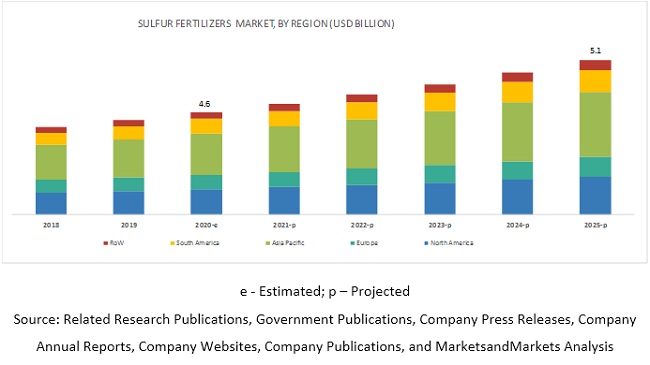The global sulfur fertilizers market is estimated to be valued at USD 4.6 billion in 2020 and is projected to reach a value of USD 5.1 billion by 2025, recording a CAGR of 2.2% during the forecast period. Factors such as the increase in sulfur deficiencies in the soil and high consumption of traditional sulfate fertilizers are projected to drive the growth of the sulfur fertilizers market.
The high demand for various crops in the Asia Pacific regions is projected to drive the growth of the market.
The increase in agricultural practices and requirements for high-quality agricultural produce are factors that are projected to drive the growth of the market in the Asia Pacific region. According to the World Bank, nearly 56.2% and 60.4% of the entire land area accounted for agricultural production in China and India, respectively, in 2015.

Major crops produced in Asia include rice, sugar beet, fruits & vegetables, cereals, and grains; the region consumes nearly 90% of the global rice produced. There is a high demand for sulfur fertilizers in Asia Pacific due to its direct use to treat sulfur deficiencies. They are often sprayed in combination or as additives to NPK products.
RoW is projected to grow at the highest CAGR during the forecast period.
The Rest of the World is segmented into South Africa, Turkey, and others in RoW, which includes Egypt, Morocco, Saudi Arabia, Iran, Israel, and Kenya. The agricultural activities in the African and Middle Eastern countries are carried out majorly, along the river banks and streams.
Most farmers in these countries are small-scale and produce grains and other products for their own consumption and sale. However, farmers in a few Middle Eastern countries are gradually becoming aware of the benefits of sulfur fertilizers with the help of non-profit and non-governmental organizations.
Key players in this market include Nutrien, Ltd. (Canada), Yara International ASA (Norway), The Mosaic Company (US), ICL (Israel), and K+S Aktiengesellschaft (Germany).
These players are focusing on increasing their presence through undertaking expansions & investments, mergers & acquisitions, partnerships, joint ventures, and agreements. They have a strong presence in North America, Asia Pacific, and Europe. In addition, they have their manufacturing facilities, along with strong distribution networks, in these regions.